 W
WSongs of Innocence and of Experience is a collection of illustrated poems by William Blake. It appeared in two phases: a few first copies were printed and illuminated by Blake himself in 1789; five years later he bound these poems with a set of new poems in a volume titled Songs of Innocence and of Experience Shewing the Two Contrary States of the Human Soul. Blake was also a painter before the creation of Songs of Innocence and Experience and had painted such subjects as Oberon, Titania, and Puck dancing with fairies.
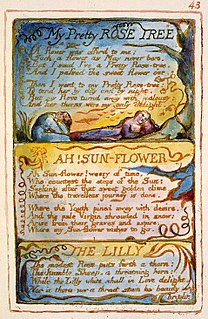 W
W"Ah! Sun-flower" is an illustrated poem written by the English poet, painter and printmaker William Blake. It was published as part of his collection Songs of Experience in 1794. It is one of only four poems in Songs of Experience not found in the "Notebook".
 W
W"The Angel" is a poem written by the English poet William Blake. It was published as part of his collection Songs of Experience in 1794.
 W
W"The Blossom" is a poem by William Blake, published in Songs of Innocence in 1789.
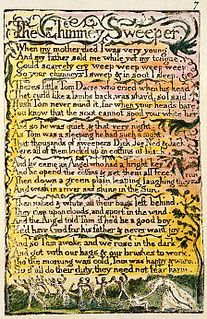 W
W"The Chimney Sweeper" is the title of a poem by William Blake, published in two parts in Songs of Innocence in 1789 and Songs of Experience in 1794. The poem "The Chimney Sweeper" is set against the dark background of child labour that was prominent in England in the late 18th and 19th centuries. At the age of four and five, boys were sold to clean chimneys, due to their small size. These children were oppressed and had a diminutive existence that was socially accepted at the time. Children in this field of work were often unfed and poorly clothed. In most cases, these children died from either falling through the chimneys or from lung damage and other horrible diseases from breathing in the soot. In the earlier poem, a young chimney sweeper recounts a dream by one of his fellows, in which an angel rescues the boys from coffins and takes them to a sunny meadow; in the later poem, an apparently adult speaker encounters a child chimney sweeper abandoned in the snow while his parents are at church or possibly even suffered death where church is referring to being with God.
 W
W"The Clod and the Pebble" is a poem from William Blake's 1794 collection Songs of Innocence and of Experience.
 W
W"A Cradle Song" is a poem written by William Blake in 1789, as part of his book Songs of Innocence.
 W
W"A Divine Image" is a poem by William Blake from Songs of Experience, not to be confused with "The Divine Image" from Songs of Innocence. The poem only appeared in copy BB of the combined Songs of Innocence and of Experience.
 W
W"The Divine Image" is a poem by the English poet William Blake from his book Songs of Innocence (1789), not to be confused with "A Divine Image" from Songs of Experience (1794). It was later included in his joint collection Songs of Innocence and of Experience (1794). In this poem Blake pictures his view of an ideal world in which the four traditionally Christian virtues–Mercy, Pity, Peace and Love–are found in the human's heart and stand for God's support and comfort. Joy and gratitude are sentiments expressed through prayer for the caring and blessing of an infallible almighty God and are shared by all men on Earth encompassing a sense of equality and mutual respect. The title of the poem refers to the Book of Genesis Chapter 1 verse 26: 'And God said: Let us make man in our image'.(KJV)
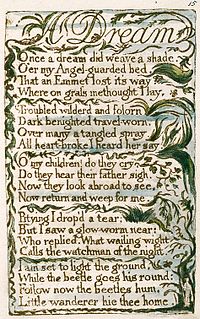 W
W"A Dream" is a poem by English poet William Blake. The poem was first published in 1789 as part of Blake's collection of poems entitled Songs of Innocence.
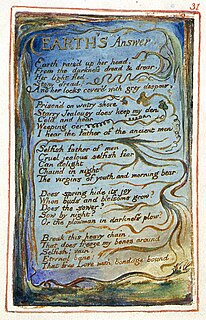 W
WEarth's Answer is a poem by William Blake within his larger collection called Songs of Innocence and of Experience. It is the response to the previous poem in The Songs of Experience-- Introduction . In the Introduction, the bard asks the Earth to wake up and claim ownership. In this poem, the feminine Earth responds.
 W
W"The Echoing Green" is a poem by William Blake published in Songs of Innocence in 1789. The poem talks about merry sounds and images which accompany the children playing outdoors. Then, an old man happily remembers when he enjoyed playing with his friends during his own childhood. The last stanza depicts the little ones being weary when the sun has descended and going to their mother to rest after playing many games.
 W
W"The Garden of Love" is a poem by the Romantic poet William Blake. It was published as part of his collection, Songs of Experience.
 W
W"Holy Thursday" is a poem by William Blake, first published in Songs of Innocence and Experience in 1794. This poem, unlike its companion poem in "Songs of Innocence" (1789), focuses more on society as a whole than on the ceremony held in London.
 W
WHoly Thursday is a poem by William Blake, from his 1789 book of poems Songs of Innocence.
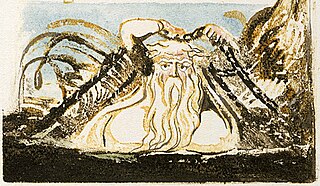 W
W"The Human Abstract" is a poem written by the English poet William Blake. It was published as part of his collection Songs of Experience in 1794. The poem was originally drafted in Blake's notebook and was later revised for as part of publication in Songs of Experience. Critics of the poem have noted it as demonstrative of Blake's metaphysical poetry and its emphasis on the tension between the human and the divine.
 W
W"Infant Joy" is a poem written by the English poet William Blake. It was first published as part of his collection Songs of Innocence in 1789 and is the counterpart to "Infant Sorrow", which was published at a later date in Songs of Experience in 1794.
 W
WInfant Sorrow is a poem by William Blake from Songs of Experience.
 W
WIntroduction to the Songs of Experience is a poem written by the English poet William Blake. It was etched and published as part of his collection Songs of Innocence and of Experience in 1794.
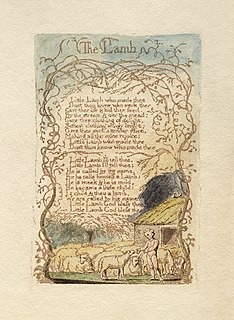 W
W"The Lamb" is a poem by William Blake, published in Songs of Innocence in 1789.
 W
W"Laughing Song" is a poem published in 1789 by the English poet William Blake. This poem is one of nineteen in Blake's collection Songs of Innocence.
 W
WThe Lilly is a poem written by the English poet William Blake. It was published as part of his collection Songs of Experience in 1794.
 W
W"The Little Black Boy" is a poem by William Blake included in Songs of Innocence in 1789. It was published during a time when slavery was still legal and the campaign for the abolition of slavery was still young.
 W
W"The Little Boy Found" is a poem by William Blake first published in the collection Songs of Innocence in 1789. Songs of Innocence was printed using illuminated printing, a style Blake created. By integrating the images with the poems the reader was better able to understand the meaning behind each of Blake's poems.
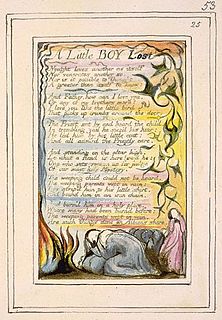 W
W"A Little Boy Lost" is a poem of the Songs of Experience series created in 1794 after the Songs of Innocence (1789) by the poet William Blake. The poem focuses on the theme of religious persecution and the corrupted dictates of dogmatic Church teachings. As part of Songs of Experience the poem is set in the wider context of exploring the suffering of innocent and oppressed individuals—in this case a young boy, and his parents—within a flawed society that is oppressed and disillusioned with life's experience.
 W
W"The Little Boy Lost" is a simple lyric poem written by William Blake. This poem is part of a larger work entitled Songs of Innocence which was published in the year 1789. "The Little Boy Lost" is a prelude to "The Little Boy Found".
 W
W"The Little Girl Found" is a poem written by the English poet William Blake. It was published as part of his collection Songs of Experience in 1794. In the poem, the parents of a seven-year-old girl, called Lyca, are looking desperately for their young daughter who is lost in the desert. During days and nights they go on looking for the girl up to the moment they find a lion which tells them where the child lies.
 W
W"A Little Girl Lost" is a poem written by the English poet William Blake. It was first published as part of his collection Songs of Innocence and of Experience in 1794. The poem is written as a clear authorial commentary from Blake, focusing on the tension between human passions and societal expectations.
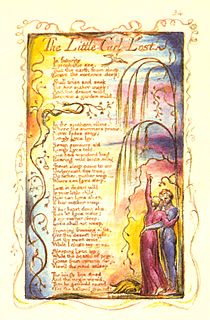 W
WThe Little Girl Lost is a 1794 poem published by William Blake in his collection Songs of Innocence and of Experience. According to scholar, Grevel Lindop, this poem represents Blake's pattern of the transition between "the spontaneous, imaginative Innocence of childhood" to the "complex and mature adult state of Experience."
 W
WThe Little Vagabond is a 1794 poem by William Blake in his collection Songs of Innocence and of Experience. His collection, Songs of Innocence, was originally published alone, in 1789. The scholar Robert Gleckner says that the poem is a form of transformation of the boy in the poem "The School Boy", from Songs of Innocence.
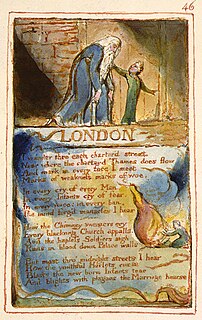 W
WLondon is a poem by William Blake, published in Songs of Experience in 1794. It is one of the few poems in Songs of Experience that does not have a corresponding poem in Songs of Innocence. Blake lived in London so writes of it as a resident rather than a visitor. The poems reference the "Two Contrary States of the Human Soul". The "Songs of Innocence" section contains poems which reference love, childhood and nature. Critics have suggested that the poems illustrate the effects of modernity on people and nature, through the discussion of dangerous industrial conditions, child labour, prostitution and poverty.
 W
WMy Pretty Rose Tree is a poem written by the English poet William Blake. It was published as part of his collection Songs of Experience in 1794.
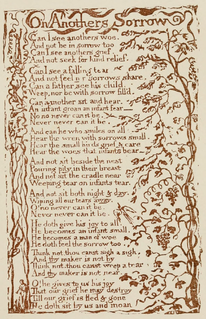 W
WOn Another's Sorrow is a poem by the English poet William Blake. The poem discusses human and divine empathy and compassion. It was published as part of the Songs of Innocence and of Experience in 1789 as the last song in the Songs of Innocence section.
 W
W"A Poison Tree" is a poem written by William Blake, published in 1794 as part of his Songs of Experience collection. It describes the narrator's repressed feelings of anger towards an individual, emotions which eventually lead to murder. The poem explores themes of indignation, revenge, and more generally the fallen state ofmankind
 W
W"The School Boy" is a 1789 poem by William Blake and published as a part of his poetry collection entitled Songs of Experience. These poems were later added with Blake's Songs of Innocence to create the entire collection entitled "Songs of Innocence and of Experience Shewing the Two Contrary States of the Human Soul". This collection included poems such as "The Tyger", "The Little Boy Lost", "Infant Joy" and "The Shepherd". These poems are illustrated with colorful artwork created by Blake first in 1789. The first printing in 1789 consisted of sixteen copies. None of the copies of Songs of Innocence are exactly alike as some of them are incomplete or were colored in posthumously "in imitation of" other copies.
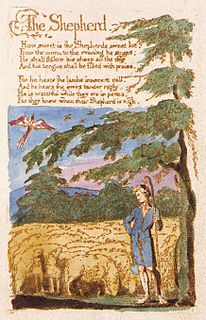 W
W"The Shepherd" is a poem from William Blake's Songs of Innocence (1789). This collection of songs was published individually four times before it was combined with the Songs of Experience for 12 editions which created the joint collection Songs of Innocence and of Experience (1794). Blake produced all of the illuminated printings himself beginning in 1789. Each publication of the songs has the plates in a different order, and sixteen other plates were published posthumously.
 W
W"The Sick Rose" is a poem by William Blake. The poem mentions through the symbols of the rose and the worm, how intense experience preys upon unpolluted innocence. The first publication was in 1794, when it was included in his collection titled Songs of Experience as the 39th plate. The incipit of the poem is O Rose thou art sick. Blake composed the page sometime after 1789, and presents it with the illuminated border and illustrations that were typical of his self publications. Most aspects of the original production were undertaken by the author; the composition of the poem and design, engraving, and promotion of the work. The printing was usually done by Blake's wife, Catherine, as well as any colouring not performed by Blake himself.
 W
WSpring is a lyric poem written and illustrated by William Blake. It was first published in Songs of Innocence (1789) and later in Songs of Innocence and Experience (1794).
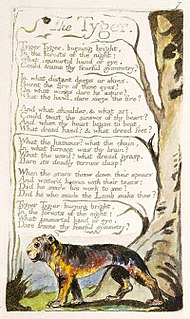 W
W"The Tyger" is a poem by the English poet William Blake, published in 1794 as part of his Songs of Experience collection. It has been the subject of both literary criticism and many adaptations, including various musical versions. Literary critic Alfred Kazin calls it "the most famous of his poems", and The Cambridge Companion to William Blake says it is "the most anthologized poem in English".
 W
WThe Voice of the Ancient Bard is a poem written by the English poet William Blake. It was published as part of his collection Songs of Innocence in 1789, but later moved to Songs of Experience, the second part of the larger collection Songs of Innocence and of Experience, 1794.